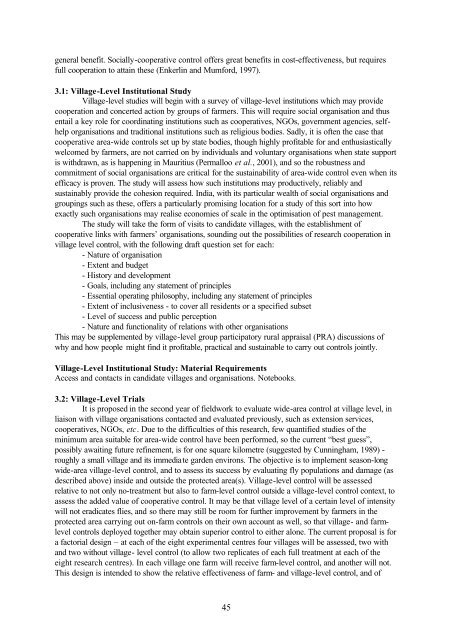“Key Informant Survey” of Production, Value, Losses and ... - DfID
“Key Informant Survey” of Production, Value, Losses and ... - DfID
“Key Informant Survey” of Production, Value, Losses and ... - DfID
You also want an ePaper? Increase the reach of your titles
YUMPU automatically turns print PDFs into web optimized ePapers that Google loves.
general benefit. Socially-cooperative control <strong>of</strong>fers great benefits in cost-effectiveness, but requires<br />
full cooperation to attain these (Enkerlin <strong>and</strong> Mumford, 1997).<br />
3.1: Village-Level Institutional Study<br />
Village-level studies will begin with a survey <strong>of</strong> village-level institutions which may provide<br />
cooperation <strong>and</strong> concerted action by groups <strong>of</strong> farmers. This will require social organisation <strong>and</strong> thus<br />
entail a key role for coordinating institutions such as cooperatives, NGOs, government agencies, selfhelp<br />
organisations <strong>and</strong> traditional institutions such as religious bodies. Sadly, it is <strong>of</strong>ten the case that<br />
cooperative area-wide controls set up by state bodies, though highly pr<strong>of</strong>itable for <strong>and</strong> enthusiastically<br />
welcomed by farmers, are not carried on by individuals <strong>and</strong> voluntary organisations when state support<br />
is withdrawn, as is happening in Mauritius (Permalloo et al., 2001), <strong>and</strong> so the robustness <strong>and</strong><br />
commitment <strong>of</strong> social organisations are critical for the sustainability <strong>of</strong> area-wide control even when its<br />
efficacy is proven. The study will assess how such institutions may productively, reliably <strong>and</strong><br />
sustainably provide the cohesion required. India, with its particular wealth <strong>of</strong> social organisations <strong>and</strong><br />
groupings such as these, <strong>of</strong>fers a particularly promising location for a study <strong>of</strong> this sort into how<br />
exactly such organisations may realise economies <strong>of</strong> scale in the optimisation <strong>of</strong> pest management.<br />
The study will take the form <strong>of</strong> visits to c<strong>and</strong>idate villages, with the establishment <strong>of</strong><br />
cooperative links with farmers’ organisations, sounding out the possibilities <strong>of</strong> research cooperation in<br />
village level control, with the following draft question set for each:<br />
- Nature <strong>of</strong> organisation<br />
- Extent <strong>and</strong> budget<br />
- History <strong>and</strong> development<br />
- Goals, including any statement <strong>of</strong> principles<br />
- Essential operating philosophy, including any statement <strong>of</strong> principles<br />
- Extent <strong>of</strong> inclusiveness - to cover all residents or a specified subset<br />
- Level <strong>of</strong> success <strong>and</strong> public perception<br />
- Nature <strong>and</strong> functionality <strong>of</strong> relations with other organisations<br />
This may be supplemented by village-level group participatory rural appraisal (PRA) discussions <strong>of</strong><br />
why <strong>and</strong> how people might find it pr<strong>of</strong>itable, practical <strong>and</strong> sustainable to carry out controls jointly.<br />
Village-Level Institutional Study: Material Requirements<br />
Access <strong>and</strong> contacts in c<strong>and</strong>idate villages <strong>and</strong> organisations. Notebooks.<br />
3.2: Village-Level Trials<br />
It is proposed in the second year <strong>of</strong> fieldwork to evaluate wide-area control at village level, in<br />
liaison with village organisations contacted <strong>and</strong> evaluated previously, such as extension services,<br />
cooperatives, NGOs, etc. Due to the difficulties <strong>of</strong> this research, few quantified studies <strong>of</strong> the<br />
minimum area suitable for area-wide control have been performed, so the current “best guess”,<br />
possibly awaiting future refinement, is for one square kilometre (suggested by Cunningham, 1989) -<br />
roughly a small village <strong>and</strong> its immediate garden environs. The objective is to implement season-long<br />
wide-area village-level control, <strong>and</strong> to assess its success by evaluating fly populations <strong>and</strong> damage (as<br />
described above) inside <strong>and</strong> outside the protected area(s). Village-level control will be assessed<br />
relative to not only no-treatment but also to farm-level control outside a village-level control context, to<br />
assess the added value <strong>of</strong> cooperative control. It may be that village level <strong>of</strong> a certain level <strong>of</strong> intensity<br />
will not eradicates flies, <strong>and</strong> so there may still be room for further improvement by farmers in the<br />
protected area carrying out on-farm controls on their own account as well, so that village- <strong>and</strong> farmlevel<br />
controls deployed together may obtain superior control to either alone. The current proposal is for<br />
a factorial design – at each <strong>of</strong> the eight experimental centres four villages will be assessed, two with<br />
<strong>and</strong> two without village- level control (to allow two replicates <strong>of</strong> each full treatment at each <strong>of</strong> the<br />
eight research centres). In each village one farm will receive farm-level control, <strong>and</strong> another will not.<br />
This design is intended to show the relative effectiveness <strong>of</strong> farm- <strong>and</strong> village-level control, <strong>and</strong> <strong>of</strong><br />
45

















